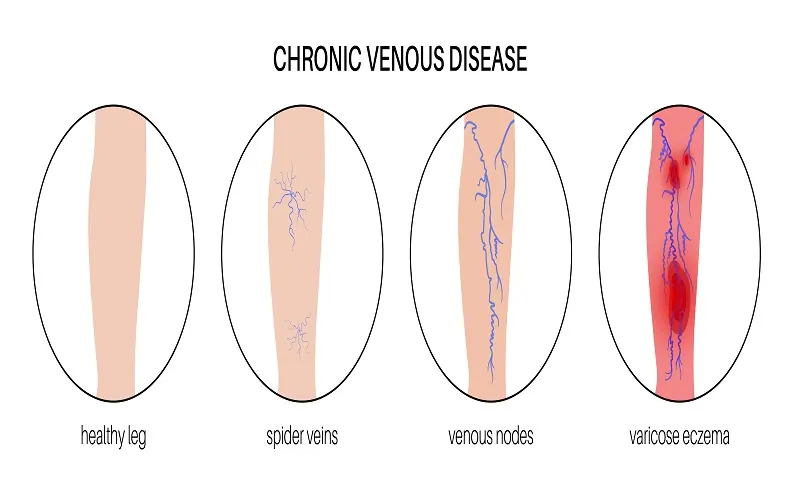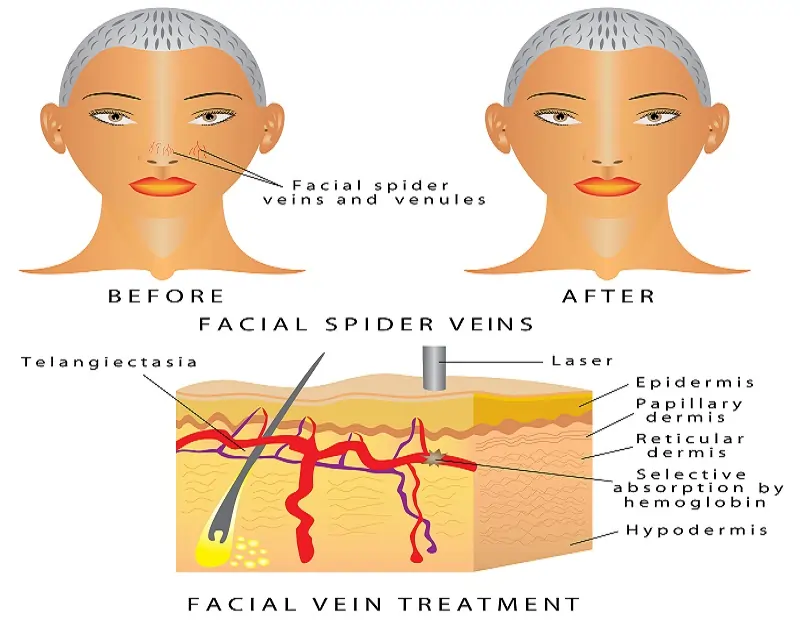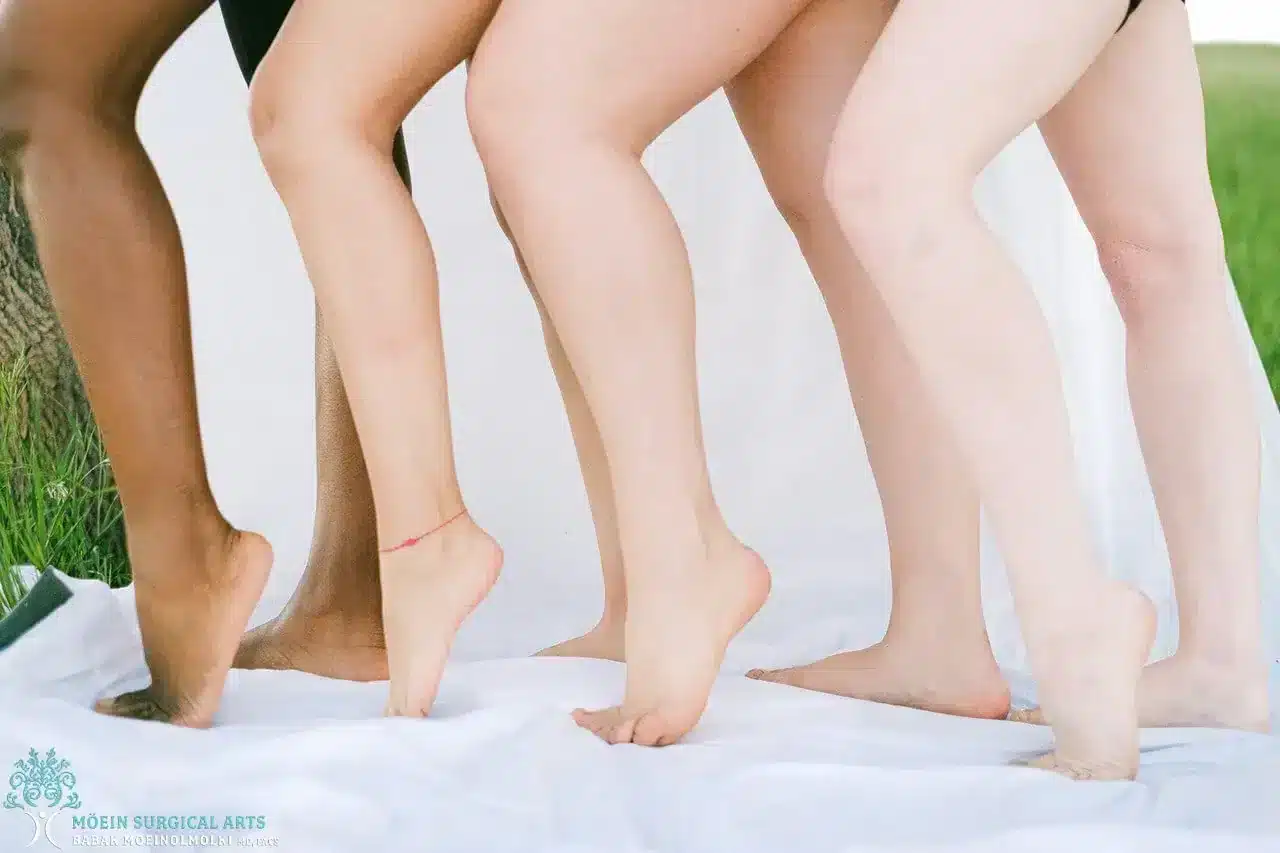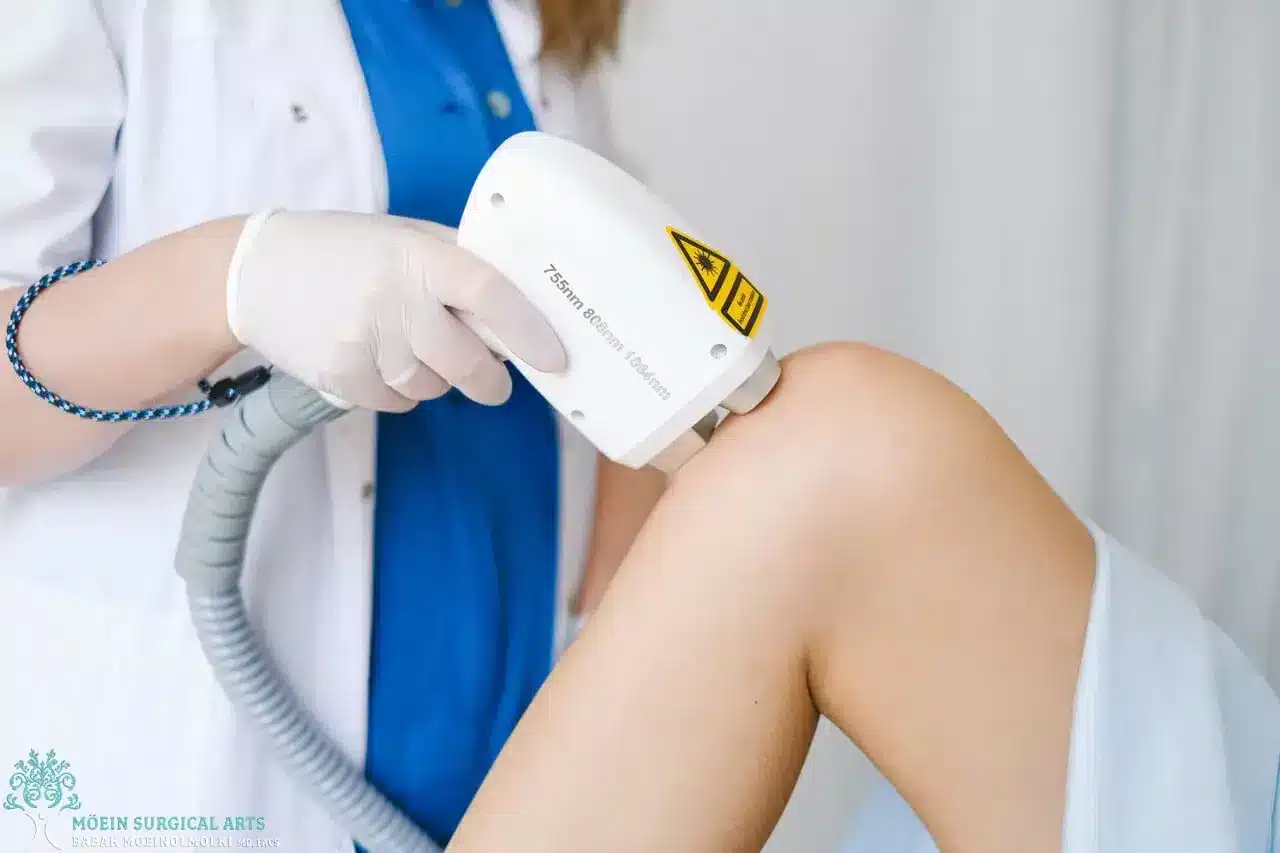
Spider veins are thin, web-like blood vessels that typically appear on the surface of the skin in shades of red, blue, or purple. Often found on the legs and face, they form when small valves within the veins weaken or fail, causing blood to pool and create these visible patterns. While spider veins are generally harmless, many people seek information on how to get rid of spider veins for both cosmetic reasons and to maintain optimal vein health.
Varicose and spider veins both represent veins that have suffered some type of damage. In healthy veins, valves inside the veins push blood in a single direction, mainly back to our heart. When the valves weaken for whatever reason, blood can flow backward, causing a buildup. With too much pressure, the vein walls can begin to bulge, causing what we all know to be varicose or spider veins.
If you don’t know the difference between the two types of veins, you’re not alone. Some people use the two terms interchangeably. Here are the facts.
If you remain unsure of what type of vein problem you are suffering from, the best course of action is to schedule a consultation with a qualified cosmetic surgeon, such as Dr. Babak Moein of Moein Surgical Arts in Los Angeles, California. A cosmetic specialist like Dr. Moein can examine your veins and help you determine the best course of treatment that might be right for you.


Several factors contribute to the development of spider veins. Heredity plays a significant role; if your family members have a history of either spider or varicose veins, you may be more prone to them. Lifestyle factors, such as prolonged standing or sitting, can increase venous pressure in the legs and exacerbate their formation. Lastly, hormonal influences especially during pregnancy or menopause can lead to changes in blood flow and vein structure, further elevating your risk. Identifying these causes can help you take proactive steps, from wearing compression stockings to considering targeted procedures, ultimately guiding you toward the most effective methods of how to get rid of spider veins.
One of the earliest indicators of spider veins is the appearance of thin, thread-like veins in shades of red or blue. These lines may gradually spread over an area of the legs or face, forming the distinctive “spider web” pattern. Although they are often more of a cosmetic concern than a health risk, it’s still essential to monitor their growth or any changes over time. If you find yourself constantly searching for how to get rid of spider veins, recognizing these warning signs early on can prompt you to explore preventative measures or seek professional advice before they become more pronounced.
Beyond their visible appearance, some individuals experience aching or mild discomfort in areas with spider veins. While this may not be as intense as the pain commonly associated with varicose veins, persistent aches or a feeling of heaviness could indicate increased venous pressure. At this stage, simple interventions such as compression stockings, lifestyle modifications, or topical treatments might help reduce symptoms.
If you notice that your spider veins are multiplying rapidly, causing significant discomfort, or accompanied by swelling, it’s wise to seek medical advice. A vein specialist can assess whether your symptoms are linked to an underlying circulatory issue and recommend targeted treatments ranging from sclerotherapy to laser therapy. Acting sooner rather than later helps ensure better outcomes, prevents potential complications, and guides you toward the most effective path to healthier, clearer skin.

Spider veins don’t only appear on the legs; they can also develop on the face, often around the nose and cheeks. Typically resembling thin, red or purple lines, spider veins on the face form when tiny veins or capillaries near the skin’s surface become dilated or damaged. Factors such as sun exposure, genetic predisposition, and certain skin conditions (like rosacea) can increase one’s likelihood of developing these visible facial veins. Additionally, lifestyle influences such as excessive alcohol consumption or frequent temperature fluctuations may exacerbate the problem by causing veins to repeatedly expand and contract.
Addressing spider veins on the face may involve both preventive measures and targeted treatments. For prevention, many dermatologists recommend applying sunscreen, wearing hats or sunglasses, and avoiding extreme temperature changes whenever possible. Effective treatment options can include laser therapy, which uses focused light to collapse affected veins, or sclerotherapy, where a medical solution is injected into the vein to make it close off and eventually be reabsorbed by the body. With proper care and early intervention, individuals can often minimize the appearance of facial spider veins and enjoy smoother, more even-toned skin.
Generally speaking, spider veins are considered more of a cosmetic issue than a serious health concern. They’re smaller and closer to the surface of the skin than varicose veins, and typically cause minimal discomfortif. However, some individuals may experience mild burning or aching sensations, especially if they stand or sit for extended periods. While spider veins aren’t usually dangerous, they can sometimes indicate underlying circulation issues. If you notice changes in appearance, discomfort, or other vein-related symptoms, it’s wise to seek professional advice. Early evaluation not only clarifies whether deeper vein problems exist but also guides you toward the most effective strategy for how to get rid of spider veins before they become more pronounced.
Engaging in exercise routines for improved circulation is one of the simplest yet most effective ways to help reduce spider veins. Low-impact workouts like walking, swimming, or cycling strengthen the leg muscles and encourage healthy blood flow back to the heart. Alongside staying active, maintaining a healthy weight further reduces stress on the veins, helping to prevent new spider veins from forming.
If your daily routine involves prolonged periods of standing or sitting, consider elevating your legs whenever possible such as during work breaks or while relaxing at home. This small shift in position helps alleviate pressure on your veins and slows the progression of existing spider veins, offering a proactive method for those looking to understand how to get rid of spider veins in a natural, ongoing manner.
You can attempt to reverse the appearance of varicose and spider veins by engaging in self-care. Tips to include with your daily regimen include exercise, elevating your legs, moving around every thirty minutes if you lead a sedentary lifestyle, and avoiding soaking in hot baths for long periods of time. These tips can prevent new veins from forming but they cannot get rid of existing varicose or spider veins. For existing veins, only cosmetic vein treatments can help.
Many people explore at-home remedies ranging from compression stockings to herbal creams in hopes of diminishing the appearance of spider veins. Compression stockings apply gentle, graduated pressure to the legs, promoting better circulation and easing mild discomfort. Meanwhile, topical creams may improve skin tone or texture, though their ability to truly eliminate spider veins can be limited. Some individuals also find temporary relief through massage and self-care strategies, which help stimulate blood flow and relieve tension.
However, it’s important to note the pros and cons of natural remedies: while these methods are generally budget-friendly and non-invasive, they may only provide minimal improvement if spider veins are already advanced. Consulting with a medical professional can help you balance at-home care with more targeted treatments to achieve the best overall results.
When lifestyle changes and home remedies aren’t enough, various medical treatments can provide more definitive solutions on how to get rid of spider veins. One of the most common techniques is laser therapy, which uses targeted light energy to heat and destroy the problematic veins. This approach is particularly effective for smaller, more superficial veins, commonly found on the face or other delicate areas. Advanced forms of laser or radiofrequency ablation may also be used to treat slightly larger or deeper veins.
While these procedures can cause mild discomfort such as a warming sensation or tingling side effects are generally minimal and temporary. Ultimately, choosing the right treatment depends on the size, location, and severity of your spider veins, as well as personal preference. Working closely with a qualified specialist ensures the best possible outcome, helping you regain smoother, clearer skin.

This skin resurfacing treatment coagulates tissue underneath the skin, making it effective to treat varicose and spider veins. Fractora is also commonly used to treat acne scars, wrinkles, and other skin problems, such as issues with skin pigmentation.
The cosmetic procedure toes the line between being a fractional laser and a surgical procedure. Considered non-surgical in nature, Fractora delivers radiofrequency energy that extends to various depths beneath the skin. A hand-held wand is used with a series of pin electrodes attached. These pins are applied directly to the skin, whereby the tissue is heated both on top and underneath the skin. The high heat coagulates and ablates the tissue, which leads to rejuvenation and contraction of the skin. The results are safe, effective, and proven to work.
Lumecca is a cosmetic treatment that originates from a company called InMode. The procedure uses IPL or intense pulsed light to restore and rejuvenate problem skin. A single treatment can visibly reduce spider veins. Surgeons can also use Lumecca IPL to treat acne scars, age spots, and other vascular lesions.
Light pulse technologies like Lumecca offer dramatic improvements quickly, which makes this treatment a favorite among cosmetic surgeons looking to treat varicose and spider veins.
The technique uses photo rejuvenation and a handheld flashgun to send pulses of intense light directly to the problematic veins. For individuals researching how to get rid of spider veins, the best part about Lumecca is that there is little downtime, yet it offers dramatic results. This device comes equipped with a refined cooling technology, making it safer and more comfortable than many other IPL systems. As a result, Lumecca has quickly become a favorite among patients seeking an effective yet gentle approach for addressing visible veins.

Yet another minimally invasive technique for problematic veins is one that you may have heard about before. CO2 fractional resurfacing has long been used to restore the signs of youth to the face and other parts of the body. Turns out, the procedure is also handy for shrinking the appearance of pesky spider veins.
Lasers are one of the most exciting developments in the cosmetic world. Advanced techniques such as the CO2 fractional laser are now available for rejuvenating and resurfacing skin.
Laser technology can reach deep down into the skin. It’s more effective than chemical peels or microdermabrasion and lasers require less downtime than other similar treatments. The technique involves treating the veins with carbon dioxide lasers directly. Doing so ablates the veins, which vaporizes the skin a single layer at a time. Heating the veins causes the tissues on and around them to coagulate, which diminishes the unsightly appearance of the veins while stimulating new collagen growth. The treatment takes only minutes to complete and will feel as though you have a sunburn around the area for at least a few days. The surgeon will use anesthetic cream during the treatment, so don’t worry about any discomfort.
Those who are exploring how to get rid of spider veins may find that additional CO₂ laser treatments are necessary, depending on the severity of their vein problem. The treatments can be spaced out in six-month intervals, allowing the skin ample time to recover and respond. Over time, your skin will appear brighter, and the veins will gradually fade, leaving healthier, more youthful-looking skin behind.
You now have several how to get rid of spider veins treatments to request when varicose or spider veins have you feeling self-conscious about your legs. Imagine seeing smooth, younger-looking skin where your problematic veins used to be. You can have your veins diagnosed so that you know exactly which type of issues you’re experiencing by scheduling a consultation with Dr. Babak Moein of Moein Surgical Arts. This personalized evaluation helps determine the most effective approach be it a minimally invasive procedure, laser therapy, or another advanced technique so that you can address your vein concerns with confidence.
Dr. Moein will invite you to visit his certified surgical center, which he uses to serve patients throughout the Los Angeles, Encino, and Glendale areas. After conducting a physical examination, Dr. Moein will be in a better position to recommend the ideal treatment for your varicose or spider veins. If you are self-conscious about your legs, this may be the most important phone call you make all year. Pick up the phone and call today – (310)455-8020.